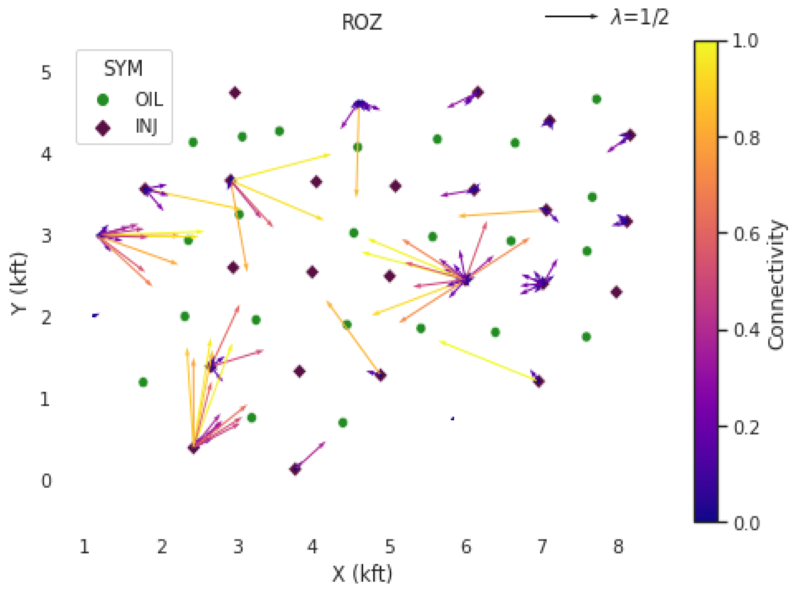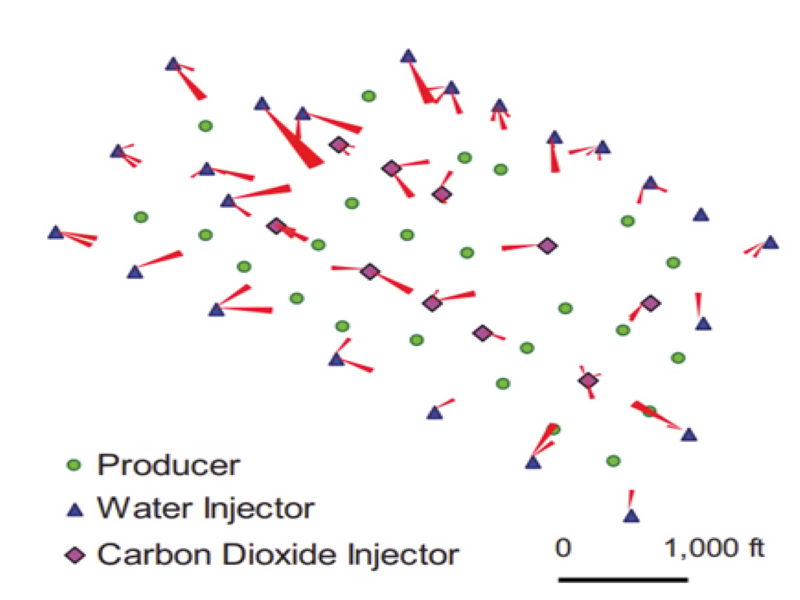Oilfields only produce a small fraction of the original resource in place during primary recovery. After that, the economic way to produce oil is by injecting water and/or chemicals into the reservoir to push oil toward the producing wells.
Understanding injector-producer connectivity is essential to an economically and environmentally successful recovery project. In the Center for Subsurface Energy and the Environment (CSEE), we are developing several tools to measure connectivity.
Connectivity can be a blessing or a curse. It is essential to have some connectivity because there must be pathways that will allow the injected fluid to push oil towards the producers. However, too much connectivity can be as bad as too little connectivity. In fact, too much connectivity can lead to water bypassing the oil on its way to the producer wells. Bypassed oil may never be recovered, and producing more water than necessary impacts the profitability and impairs the environmental profile of the project.
The traditional approach for determining connectivity requires building project-sized three-dimensional geomodels and painstakingly history-matching field responses to reservoir simulation. While this practice can lead to excellent results, it suffers from two drawbacks: 1) the time from starting geologic characterization to a successful history match may be long, delaying project decisions and implementation, and 2) the entire process is very data-intensive, and sometimes those data never were collected or they have been lost.
Capacitance resistance models provide fast, actionable feedback for improved oil recovery projects and can independently check geologic reservoir models. How do capacitance resistance models do this? They are built through analyzing production and injection rate data and trying to infer the connectivity of the reservoir between those wells (Yousef et al., 2006). These models use the natural fluctuations in injection rates caused, for example, by changing operating conditions and scheduled maintenance to find the best correlation between the fluctuations of the injectors and producers.
In this project, we develop and apply methods for Texas operators to measure oilfield connectivity. This information can help them adjust injection rates and identify favorable locations for new wells (Fig. 1). For example, well spacing in the east of Fig. 1 (to the right) should be smaller than in the west to maintain sufficient connectivity for economic recovery. Indeed, some producers are not connected to any injectors at all.

Figure 1. Residual oil zone connectivity map for a small west Texas field. Oil wells are in green, injectors in purple. The connectivity is a value between 0 and 1. Each arrow’s length is proportional to the connectivity between the injector and producer. Eastern injectors are in a poorly connected part of the field while western injectors are in better-connected locations. (From Male et al., in prep)
Operators can use capacitance resistance models to improve reservoir management in real time (de Holanda et al., 2018). In closed-loop reservoir management systems, these models can dynamically balance injection rates in the field to maximize oil recovery without requiring human intervention. This is only possible because of the rapid calculations that capacitance resistance models can make, several times faster than reservoir simulation.
These tools have been successfully tested in a variety of field conditions. Among the nontraditional improved oil recovery methods where capacitance resistance models have been run are CO2 floods (Figure 2) and floods between hydrofractured horizontal wells (Mirzayev, et al., 2017). Importantly, these models provide small field operators—who may not have the resources to create and use complicated reservoir models— with a way to improve the management of improved oil recovery processes to reduce unnecessary water production and recover more oil.

Figure 2. Connectivity map for a large west Texas field. The connectivity is a value between 0 and 1. Each red arrow’s length is proportional to the connectivity between the injector and producer. Southeastern injectors are in a poorly connected part of the field while northwestern injectors are in better-connected locations. (From Sayarpour et al., 2009)
Our current work includes training capacitance resistance models on production from floods of the residual oil zone (Figure 1), a major potential source of oil that has only recently received interest in west Texas (Ren and Duncan, 2021). Major practical challenges for determining connectivity include how to deal with: 1) old fields where injection and production rates may be missing or only reported on a unit basis; and 2) fields where the waterflood was implemented in a piecemeal fashion.
We have built a python-based, open-source capacitance resistance modeling package and released it to the public at https://github.com/frank1010111/pyCRM. This package allows anyone with production and injection rate data and some familiarity with programming fundamentals to perform several varieties of capacitance resistance modeling on their own field.
References
Ren, B. and Duncan, I.J., 2021. Maximizing oil production from water alternating gas (CO2) injection into residual oil zones: The impact of oil saturation and heterogeneity. Energy, 222, p.119915.
de Holanda, R.W., Gildin, E. Jensen, J.L., Lake, L.W. and Kabir, C.S., A State-of-the-Art Literature Review of Capacitance Resistance Models for Reservoir Characterization and Performance Forecasting, Energies 11 (12), 1-46, 2018; doi: 10.3390/en11010001.
Mirzayev, M., Riazi, N., Cronkwright, D., Jensen, J.L. and Pedersen, P.K., 2017. Determining well-to-well connectivity using a modified capacitance model, seismic, and geology for a Bakken Waterflood. Journal of Petroleum Science and Engineering, 152, pp.611-627.
Sayarpour, M., Kabir, C.S. and Lake, L.W., 2009. Field applications of capacitance-resistance models in waterfloods. SPE reservoir evaluation & engineering, 12(06), pp.853-864.
Yousef, A.A., Gentil, P.H., Jensen, J.L. and Lake, L.W., 2006. A capacitance model to infer interwell connectivity from production and injection rate fluctuations. SPE Reservoir Evaluation & Engineering, 9(06), pp.630-64


